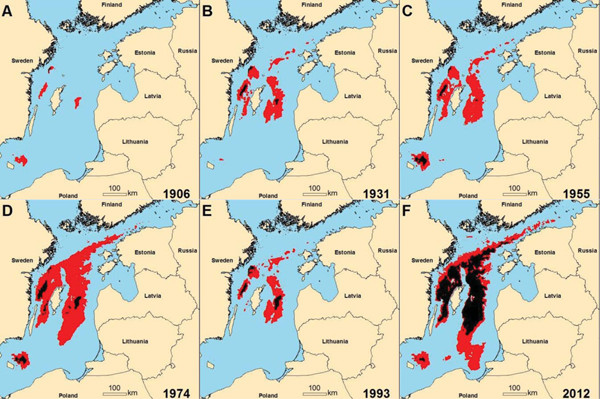
by Timothy Oleson Tuesday, August 19, 2014

Hypoxic (red) and anoxic (black) deep waters in the Baltic Sea extend over a far larger area today than they have historically. Credit: J. Carstensen et al. Proceedings of the National Academy of Sciences, 2014.
Low-oxygen, or hypoxic, deep waters now extend over an area of about 60,000 square kilometers in the Baltic Sea, a tenfold increase compared to 115 years ago, according to a recent study published in Proceedings of the National Academy of Sciences. The hypoxic zone has fluctuated substantially in that period, but much of the expansion has occurred in recent decades as a result of large inputs of nutrients like nitrogen and phosphorus from human activities such as agriculture, reported Jacob Carstensen of Aarhus University in Denmark and colleagues.
The expansion of hypoxic waters — defined as water with less than 2 milligrams of oxygen per liter — shrinks habitable zones for most marine life. The condition results from nutrient influxes, which spur large blooms of plankton that consume oxygen as they decay and sink through the water column. But climatic conditions, including warming temperatures that decrease the solubility of oxygen in seawater, can also induce hypoxia.
To parse the contributions of different factors to hypoxia in the sea — which are exacerbated by the Baltic’s limited connection to oxygen-replenishing oceanic water — Carstensen’s team examined thousands of temperature, salinity and oxygen records collected in various countries and dating back to 1898. The researchers wrote that while warming water temperatures and inflow of ocean water into the sea modulate Baltic hypoxia, “anthropogenic nutrient discharges are the primary driving factor creating widespread hypoxic conditions.” Similar conclusions have been drawn in past work on the well-known dead zones in the Gulf of Mexico and Chesapeake Bay, the team noted.
© 2008-2021. All rights reserved. Any copying, redistribution or retransmission of any of the contents of this service without the expressed written permission of the American Geosciences Institute is expressly prohibited. Click here for all copyright requests.